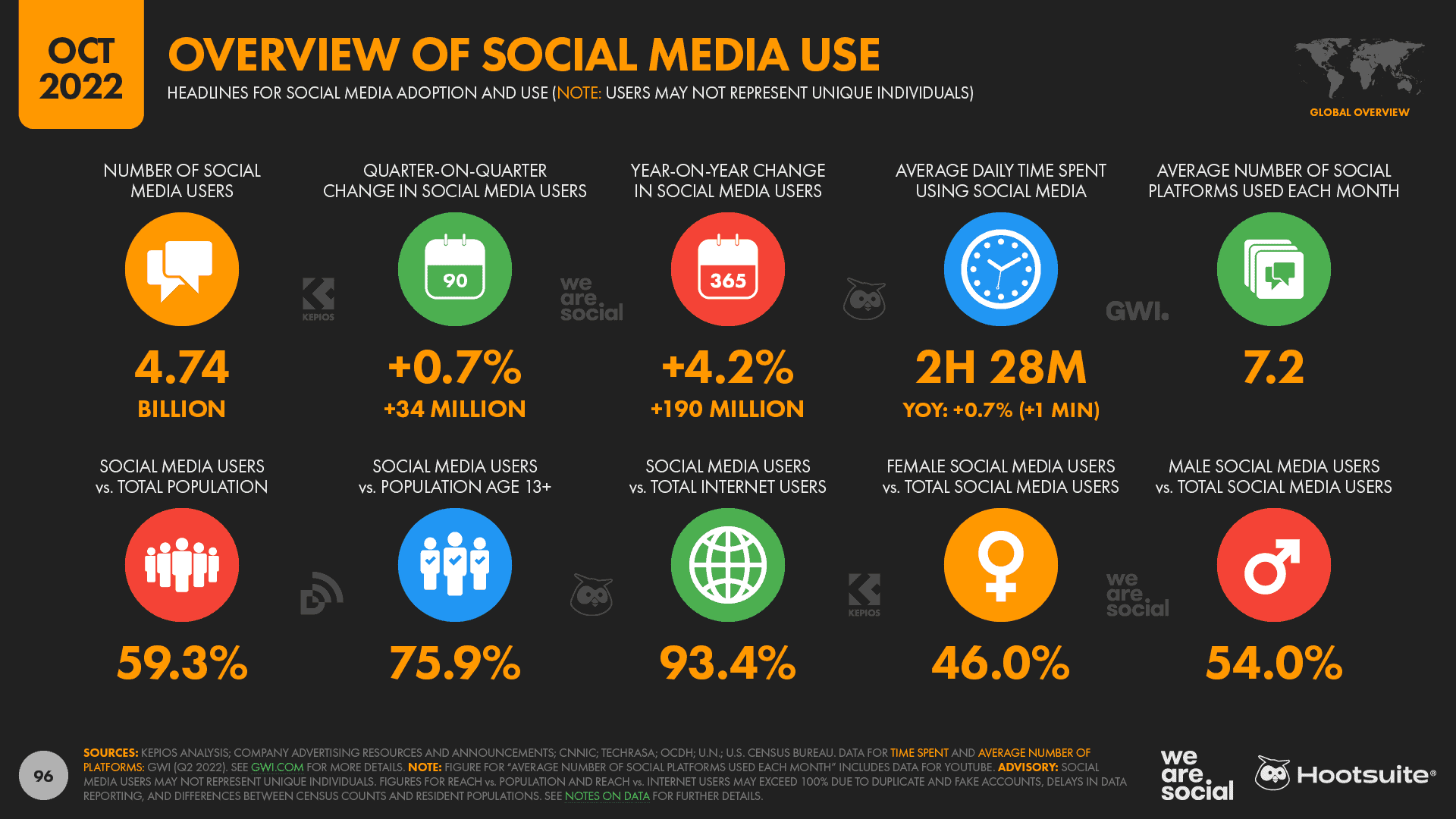- Select the right social media platforms for your brand.
- Establish clear goals for everything you post.
- Engage with your followers.
- Maintain consistency with your voice, creative assets, and publishing schedule.
- Create customer personas.
You’ve worked hard to create a brand that reflects your company’s services and story. Maybe you’ve even invested in branded swag like t-shirts and pens with your logo and web address. But how about your social media? Have you spent time creating or maintaining your brand identity on your digital networks?
Innovative companies use social media to leverage brand awareness. “Social media users grew by 190 million over the past year to reach 4.74 billion at the start of October 2022,” reports Datareportal. Harnessing the power of networks like Facebook, Instagram, or LinkedIn is worth the time and effort, especially if you develop and adhere to social media brand guidelines.

Overview of Global Social Media Use October 2022 DataReportal
Brand Guidelines
Working with a brand agency, your company should have received a brand guideline document. If you developed your brand independently, you might not have guidelines in place. Typical contents include:
- Brand colors with hex, CMYK, and RGB codes
- Color logo files and instructions, such as
- Background colors to avoid
- How the iconography should be displayed in your logo
- Required spacing around your logo
- The minimum size your logo can be
- Primary and secondary font files
These are the elements you’ll find on your website and your swag that anchor the visual and psychological connections for your brand identity. They’re the basic ingredients that you’ll need to incorporate into your social media brand guidelines.
“Not all social media platforms are the same, and not every business needs the same platforms.”
The Social Media Brand Guidelines
Audience
Now is a perfect time for a little creative writing. Imagine your primary and secondary audiences. Think about your primary audience as the decision-maker who can generate revenue for your business. Your secondary audience is just as influential. They might not be immediate purchasers or impact your bottom line, but you still want them coming to you, not your competition.
Give these audiences a personality, name, and backstory so that you know how to appeal to them, talk to them, and relate to them. Suggest the income level you want them to have and their level of education. You’ll have a very clear picture of the person you craft your social media campaigns.
 Choose the Right Platforms
Choose the Right Platforms
Not all social media platforms are the same, and not every business needs the same platforms. Take a look at your competitors. Where are they having success online, and where are they floundering? Display your brand and your business where it makes the most sense. Also, take into consideration how much time you have. It’s better to be great at one rather than mediocre at many.
The platform that makes the most sense depends on your service or product and your audience. Where will your customers be?
Not only is Facebook the most widely used social media network, but it’s also the starting point for most people when it comes to looking for your company’s social presence online. In fact, without a Facebook business account, you’ll delegitimize a wide swath of your potential audience. Whether you love it or hate it, if your customer base is more than 30, you almost have to play the Meta game.
Instagram is owned by Facebook, but it’s an entirely different social media channel with distinct rules for success. This might be a perfect match if your company’s brand sells products online. See if your competitors use it; if they’re not, maybe you just found your brand’s niche.
Think of Pinterest as a scrapbooking site. Create boards of your company’s favorite things for customers to use as inspiration. It’s a great way to establish yourself as a creative leader in your industry.
There are undoubtedly other avenues to explore, like TikTok, LinkedIn, and Snapchat. Each has its unique demographic and purpose. It’s a matter of deciding what makes sense for who you are appealing to, what you’re selling, and what your brand represents.
“Consistency is the key to brand identity.”
Consistency
Consistency is the key to brand identity. It’s why you have a logo, brand colors, and typography. These are the elements that make your brand stand out in the marketplace. When using social media, everything you post needs the same level of consistency. From setting up your company’s avatar (aka profile picture) to the cover image on all your platforms, they should be cohesive and readily identifiable. The company bio on Facebook should be the same as the bio on Instagram, and the brand’s voice should be identical across platforms. Otherwise, you’ll confuse current and potential customers. Consistency creates trust, and trust builds brand awareness and brand converts.
 Creative Visuals
Creative Visuals
Your voice and tone can be ideal, but without the perfect image, it won’t mean much. For most social media, it’s all about visuals. Captivating imagery will interest users in what you have to say and offer. The range of creative and clever ways to represent your brand includes:
- Photos
- Videos
- GIFs
- Illustrations
- Infographics
- Memes
Your social media guidelines should include that your visuals reflect your brand identity. For instance, add your logo to your videos. Use your branded font on infographics. Incorporate brand colors in the graphics you use. All of these techniques ensure that your brand becomes more and more recognizable to anyone who sees it.
Social Media Engagement
Don’t post and forget about it. One way to ruin your brand’s reputation is by neglecting the comments, likes, and questions generated by your posts. Schedule at least two weekly sessions to review and react to users if you don’t have a scheduling platform with a listening function. Use your brand voice, be authentic, and demonstrate why people should want to do business with your company. Social media is all about starting conversations.
“Document your guidelines, and update them twice a year.”
Review and Refine
Once you’ve implemented your social media brand guidelines, give them some time. Set yourself a task to review your data after three months. By then, you’ll have a good overview of the content that performed well, the time of day and day of the week your customers are online, and which platform is most effective. Use all this information to refine the next three month’s social media strategy. Continue to review and refine because the platforms are constantly changing their services and algorithms, and your company probably has updates it needs to make, too.
Write it Down
Document your guidelines and update them twice a year. Your whole team will thank you. Include social media image dimensions, your brand colors, logo dos and don’ts, brand voice, company audiences, etc. Because social media isn’t going anywhere, these guidelines won’t either.
Brand Preservation and Social Media
Once you’ve spent energy building your brand, sharing it with the world is exhilarating. Aside from your website, social media is the best way to give it the exposure it deserves. Establishing thoughtful social media brand guidelines will maintain your company’s integrity and brand identity exactly where your customers are looking for you.
Kudzu Brands creates assets and social media guidelines that will make your digital presence a success. Contact us for a consultation to get the conversation started.

